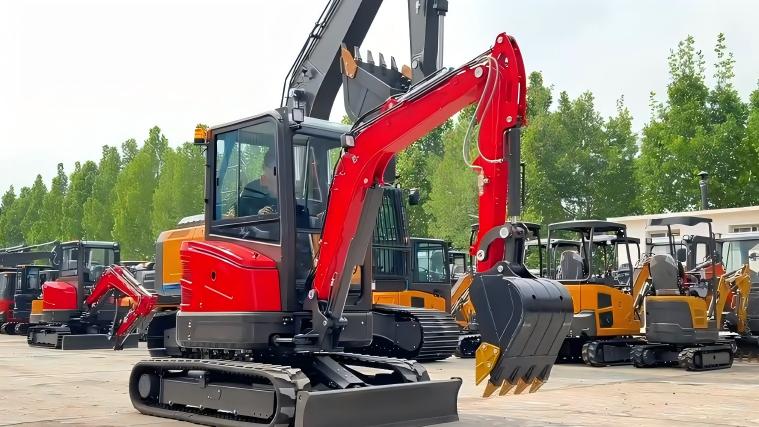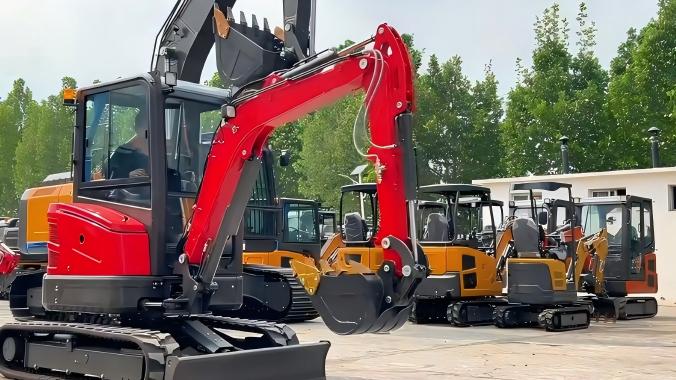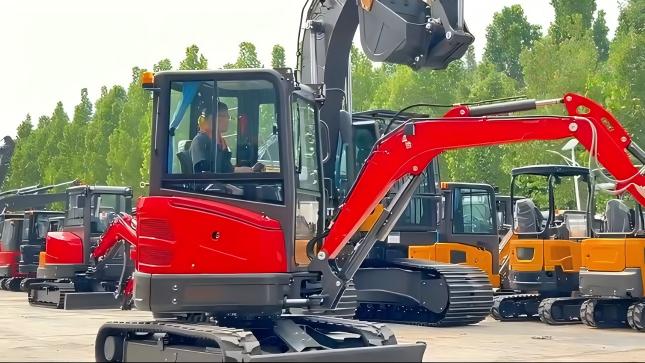Understanding Excavator Systems: A Prerequisite for Effective Maintenance
Before detailing specific maintenance tasks, it's crucial to understand the major systems that comprise an excavator. These interconnected components work in harmony, and an issue in one system can often cascade, affecting others.
Engine System: The heart of the excavator, providing power for all hydraulic functions and movement. This includes the engine itself, cooling system, fuel system, air intake, and exhaust.
Hydraulic System: The muscle of the excavator, responsible for arm, boom, bucket, and swing movements. This system comprises pumps, valves, cylinders, hoses, and hydraulic fluid.
Undercarriage System: The foundation of the excavator, enabling mobility. Key components include tracks, idlers, rollers, sprockets, and travel motors.
Electrical System: Controls and monitors various functions, including starting, lighting, and sophisticated electronic systems. This includes the battery, alternator, starter, wiring harnesses, and control modules.
Lubrication System: Ensures smooth operation and reduces wear between moving parts. This involves various greasing points and oil reservoirs.
Structural Components: The main frame, boom, arm, and bucket, which bear the brunt of operational forces.
Daily Checks: The First Line of Defense
Daily pre-operation checks are paramount for identifying potential issues before they escalate. These quick inspections, typically performed before each shift, can prevent major damage and ensure safe operation.
Fluid Levels: Check engine oil, hydraulic fluid, coolant, and fuel levels. Top off as needed. Low fluid levels can lead to overheating, component damage, and reduced performance.
Leaks: Inspect for any signs of oil, hydraulic fluid, or coolant leaks around hoses, fittings, cylinders, and the engine. Even small leaks can indicate a developing problem.
Hoses and Lines: Examine hydraulic hoses for cracks, bulges, chafing, or signs of wear. Damaged hoses can burst under pressure, leading to sudden loss of function and safety hazards.
Greasing Points: Lubricate all accessible grease points on the boom, arm, bucket pins, and swing bearing. Regular greasing reduces friction and wear.
Tracks and Undercarriage: Check track tension, looking for excessive slack or tightness. Inspect rollers, idlers, and sprockets for unusual wear or damage. Remove any accumulated debris that could interfere with track movement.
Engine Compartment: Look for loose belts, debris, or anything unusual. Ensure air filters are clean and free of obstructions
Safety Features: Verify the functionality of lights, horn, backup alarm, and safety interlocks.
Attachments: If using specific attachments (e.g., hydraulic hammer, ripper), inspect their connections and components for wear or damage.
Weekly Maintenance: A Deeper Dive
Weekly checks build upon daily inspections, focusing on components that require slightly less frequent attention.
Air Filter Inspection: Remove and inspect the engine air filter. Clean or replace if excessively dirty. A clogged air filter restricts airflow, reducing engine performance and increasing fuel consumption.
Cooling System: Check the radiator and oil cooler fins for blockages from dirt or debris. Clean them using compressed air or water to ensure efficient heat dissipation.
Battery Terminals: Inspect battery terminals for corrosion. Clean them with a wire brush and apply dielectric grease to prevent future corrosion. Ensure terminals are securely tightened.
Electrical Connections: Visually inspect accessible electrical connections for looseness or corrosion.
Tire Pressure (if applicable): For wheeled excavators, check tire pressure and inflate to the manufacturer's recommendations.
Track Tension Adjustment: Adjust track tension if necessary, following the manufacturer's guidelines. Improper track tension can lead to premature wear of undercarriage components.
Bucket Teeth and Edges: Inspect bucket teeth and cutting edges for wear or damage. Replace them promptly to maintain digging efficiency and prevent further damage to the bucket itself.
Monthly/Bi-Monthly Maintenance: Preventive Measures
These tasks are more involved and often require specialized tools or expertise. They are crucial for preventing major component failures.
Oil and Filter Changes:
Engine Oil and Filter: Change engine oil and oil filter according to the manufacturer's recommended intervals. Used oil loses its lubricating properties and can lead to increased engine wear.
Hydraulic System Filter: Replace hydraulic oil filters. Contaminated hydraulic fluid can damage pumps, valves, and cylinders.
Fuel Filter: Replace fuel filters. Clogged fuel filters can restrict fuel flow, leading to engine performance issues and potential damage to the fuel injection system.
Grease Swing Bearing: Apply grease to the swing bearing, often requiring multiple pump strokes to ensure adequate lubrication.
Drive Belt Inspection: Check the tension and condition of engine drive belts. Replace cracked, frayed, or excessively worn belts.
Coolant System Flush and Replacement: Periodically flush the cooling system and replace the coolant. Over time, coolant can lose its corrosion-inhibiting properties.
Hydraulic Oil Sample and Analysis: Consider taking hydraulic oil samples for laboratory analysis. This can detect contaminants, wear metals, and the overall condition of the fluid, providing early warning of potential hydraulic system issues.
Undercarriage Wear Measurement: Measure the wear on undercarriage components (links, rollers, idlers, sprockets) using specialized gauges. This helps predict component life and plan for future replacements.
Annual/Bi-Annual Maintenance: Comprehensive Overhauls
Annual or bi-annual maintenance is a more thorough inspection and service, often performed by qualified technicians.
Hydraulic Oil Replacement: Replace the entire hydraulic oil. While filters remove contaminants, over time, the base oil can degrade.
Gearbox Oil Changes: Change the oil in the swing gearbox and final drive gearboxes.
Valve Clearances: Check and adjust engine valve clearances as per
manufacturer specifications
Fuel Injector Inspection: Inspect fuel injectors for proper spray pattern and operation.
Hydraulic Pump and Motor Inspection: Inspect hydraulic pumps and motors for leaks, unusual noises, or signs of wear.
Electrical System Check: Conduct a comprehensive electrical system check, including testing the alternator and starter, and inspecting all wiring harnesses for damage.
Structural Crack Inspection: Thoroughly inspect the boom, arm, and frame for any signs of cracks or structural fatigue. Weld repairs should only be performed by certified welders.
Pin and Bushing Inspection: Inspect all pins and bushings for excessive play. Replace worn components to prevent further damage to the connecting points.
Pressure Relief Valve Testing: Test the hydraulic pressure relief valves to ensure they are functioning correctly and at the correct pressure settings.
The Role of Technology in Modern Excavator Maintenance
Modern excavators are increasingly equipped with advanced telematics and diagnostic systems that can significantly enhance maintenance efforts.
Telematics Systems: These systems can transmit real-time data on fuel consumption, engine hours, fault codes, and GPS location. This allows for proactive scheduling of maintenance, remote diagnostics, and optimized fleet management.
Onboard Diagnostics (OBD) Systems: Excavators often have sophisticated OBD systems that store fault codes, aiding technicians in quickly identifying and troubleshooting issues.
Predictive Maintenance: Leveraging data from telematics and sensor networks, predictive maintenance uses algorithms to forecast potential equipment failures, allowing for scheduled maintenance before a breakdown occurs, minimizing downtime.
Safety First: A Core Principle of Maintenance
Safety must be the paramount concern during all maintenance activities.
Lockout/Tagout: Always follow strict lockout/tagout procedures to prevent accidental startup of the excavator.
Personal Protective Equipment (PPE): Wear appropriate PPE, including safety glasses, gloves, hard hat, and steel-toed boots.
Proper Tools: Use the correct tools for each task to prevent damage to components and ensure safety.
Cleanliness: Maintain a clean work environment to prevent contamination of fluids and components.
Manufacturer's Manual: Always refer to the excavator's specific operator's manual and service manual for detailed instructions and specifications.
Conclusion
Excavator maintenance is not merely a reactive measure but a proactive investment. A well-executed maintenance program, encompassing daily checks, regular servicing, and periodic overhauls, is essential for maximizing an excavator's operational efficiency, extending its service life, and ensuring the safety of personnel. By adhering to these guidelines and embracing technological advancements, operators and fleet managers can significantly reduce downtime, lower operating costs, and ensure their excavators remain productive and reliable assets for years to come. Neglecting these vital procedures is a sure path to premature wear, costly repairs, and ultimately, a detrimental impact on project timelines and profitability.
Post time:Sep-25-2020



